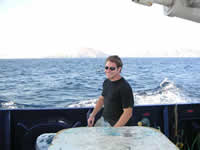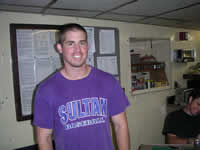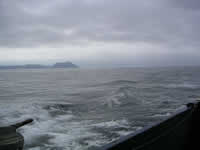


|
The Project Part 1: Part 2: Part 3:
|
10 August, 2005
|
 Matt, AB  Will, Oiler  Cedros Island, North Baja Note the change in sea color on the Pacific side of Baja. |
More from The Log from the Sea of Cortez
Tex, our engineer, was caught in the ways of the harbor. He was born in the Panhandle of Texas and early he grew to love Diesel engines. They were so simple and powerful, blocks of pure logic in shining metal. They appealed to some sense of neat thinking in Tex.
Sparky Enea and Tiny Colletto (the deckhands) grew up together in Monterey and they were bad little boys and very happy about it. It is said lightly that the police department has a special detail to supervise the growth and development of Tiny and Sparky.
Matt: AB
Matt hails from Maryland where he attended the Piney Point Harry Lumbaugh School of Seamanship, which is run by the Seafarers International Union. He attended school there for about one year. He decided at a very young age to work on the seas; his father gave him a child’s version of Moby Dick and he was inspired to go to sea. He’s the only person in his family to work on the water.
Matt’s been an AB (Able Bodied Seaman) for about five years. He worked for the Military Sealift Command which delivers supplies for the US military. These ships carry enough goods to supply 1000 marines with enough food, ammunition and medical supplies for 90 days if they are invading a country. These ships carry trucks, helicopters and bombs. It is a civilian job, but carries some military strictures; for example, leaving your job without permission can get you in big trouble.
He’s sailed to Korea, Guam, Saipan, Roto (in the Marianas), Tokyo and Okinawa. Matt has also sailed the entire east coast of the US, including the Caribbean, working on a US Environmental Protection Agency research ship. But his favorite place was Saipan, where there is great snorkeling (often among plane and ship wrecks from WWII) because he loves the Polynesian people, their culture and life style.
The scariest thing he’s experienced at sea was a fuel-fed engine room fire that took 49 minutes to put out. One sailor was injured quite severely, but did eventually recover. He was on a research vessel north of Hawaii in 44-foot seas that he found “one step beyond aggravating.”
What does he like about being an AB? The money is great (he and his wife own their home and he drives a Jaguar), the food’s always good and he loves to travel. Since his home is in Maryland, and the R/V New Horizon is based in San Diego, Matt is considered a “live aboard” crew member; he flies home whenever he has enough time off. He was unhappy with his last position and found his current job by sending his resume to the Scripps Institute of Oceanography. Because he had experience on a research vessel on the East Coast, he was hired on.
Matt says that a married sailor needs a “high caliber partner” to put up with being left at home alone a lot. It’s easier for single people to do this kind of work. His advice to aspiring seamanship students: get as much training as you can as cheaply as possible and it’s not necessary to be in a union to work as an AB.
Will: 4th Engineer
Will came to work on the New Horizon because he’s always worked on car engines. He was selling used cars in San Diego and worked as a tennis coach. He wasn’t happy with these jobs because they didn’t pay well; he had to quit selling cars because he “developed a heart.” He tried college and decided it wasn’t right for him. Working on the ship pays good money and there’s lots of room for advancement without a college education.
Will has been working on this ship for a year and a half. He has a “mechanical type of mind” which comes in handy because he is required to work as a plumber, electrician, and as an engineer. During his shift (4 hours on, 8 off), he makes “runs” which involve checking to see that all the equipment is working properly. He looks at the stats and monitors the equipment to catch problems before they occur.
Right now he’s a “wiper,” which means he is an unqualified engineer. Will hopes Scripps will pay to send him to “oiler” school in January for two months, which will make him a qualified engineer. There he’ll also get training in safety, firefighting and life guard skills (in case someone falls off the ship). After oiler school, there are other trainings that will advance him as an engineer; these courses of study are very expensive. He says if Scripps likes him, it might help him get more schooling, and if not, he’ll pay for it himself.
The most dangerous situation Will has experienced at sea was being attacked by an irate pelican! But being at sea has other disadvantages; he misses seeing his brothers and sisters grow up and it’s really hard to keep a girlfriend because he’s away from shore so much. Will is also a “live aboard” like Matt. Both of them like to say that they live in a very exclusive area of San Diego, right on the water. His advice for people who want to be engineers: don’t eat too much on your first few trips because it makes the seasickness worse. And be sure to bring along a Play Station and an X-Box to keep yourself occupied during downtimes.
Math Problem:
We’re going to combine all our pictures on one CD. The disk holds 700 MB of data. My pictures will take up 270 MB and Elisa’s 310 MB. What percentage of the disk will have no data on it?
Trivia Tidbit of the Day:
There are about 7,000 species of seaweeds. All of the species are simple organisms called algae. The name seaweed incorrectly implies that these organisms have little value. Actually, many seaweeds are rich in vitamins and minerals and are eaten in various parts of the world. Seaweeds also have many industrial uses. Brown algae yield a gummy substance called algin and red algae produce jellylike substances called agar and carrageenin. Manufacturers add these substances to various foods and drugs to give them a smooth texture and help them retain moisture. Manufacturers also use algins in lipsticks, soaps, photographic film, paint, varnish, and buttons. Agar serves as a culture medium, a base on which bacteria are grown in scientific laboratories.
![]()
